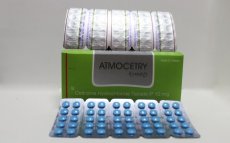
Composition
- Each Tablet Contains:
- Cetirizine Hydrochloride IP
10 mg
Packing
- 10x5x10
(Blister)
MRP
- 21
Overview
Cetirizine is an antihistamine that reduces the natural chemical histamine in the body. Histamine can produce symptoms of sneezing, itching, watery eyes, and runny nose. It is used to treat cold or allergy symptoms such as sneezing, itching, watery eyes, or runny nose.
Cetirizine is also used to treat itching and swelling caused by hives.
ATMOCETRY is used for?
- For the relief of symptoms of hay fever (seasonal allergic rhinitis) and allergies such as dust or pet allergies (perennial allergic rhinitis), such as sneezing, itchy, runny and blocked nose, red and watery eyes.
- For the relief of swelling, redness and itchiness of the skin (symptoms of chronic idiopathic urticaria, which is also known as chronic nettle rash).
Warnings
Do NOT use Cetirizine:if you have a severe kidney disease (severe renal failure with creatinine clearance below 10 ml/min).
if you are known to be allergic (hypersensitive) to the active substance of Cetirizine 10 mg Tablets or any of the other ingredients of these tablets.
if you are known to be allergic (hypersensitive) to hydroxyzine (closely related active substances of other medicines).
if you are known to be allergic (hypersensitive) to drugs from the piperazine family, for example buclizine, cyclizine, meclozine, levocetirizine.
Contraindications
Cetirizine hydrochloride Tablet is contraindicated in those patients with a known hypersensitivity to it or any of its ingredients or hydroxyzine.
Side Effects
Dizziness,drowsiness, dry mouth, sore throat, cough, nausea, constipation, headache, tired feeling.
Storage
Keep out of the reach and sight of children.
This medicine does not require any special storage conditions.
Pharmacology
Mechanism of Action
Cetirizine, a human metabolite of hydroxyzine, is an antihistamine; its principal effects are mediated via selective inhibition of peripheral H1 receptors. The antihistaminic activity of Cetirizine has been clearly documented in a variety of animal and human models. In vivo and ex vivo animal models have shown negligible anticholinergic and antiserotonergic activity. In clinical studies, however, dry mouth was more common with Cetirizine than with placebo. In vitro receptor binding studies have shown no measurable affinity for other than H1 receptors.
Autoradiographic studies with radiolabeled Cetirizine in the rat have shown negligible penetration into the brain. Ex vivo experiments in the mouse have shown that systemically administered Cetirizine does not significantly occupy cerebral H1 receptors.
Pharmacokinetics
Absorption:
Cetirizine was rapidly absorbed with a time to maximum concentration (Tmax) of approximately 1 hour following oral administration of tablets or syrup in adults. Comparable bioavailability was found between the tablet and syrup dosage forms. When healthy volunteers were administered multiple doses of Cetirizine (10 mg tablets once daily for 10 days), a mean peak plasma concentration (Cmax) of 311 ng/mL was observed. No accumulation was observed. Cetirizine pharmacokinetics were linear for oral doses ranging from 5 to 60 mg. Food had no effect on the extent of Cetirizine exposure (AUC) but Tmax was delayed by 1.7 hours and Cmax was decreased by 23% in the presence of food.
Distribution:
The mean plasma protein binding of Cetirizine is 93%, independent of concentration in the range of 25 to 1000 ng/mL, which includes the therapeutic plasma levels observed.
Metabolism:
A mass balance study in 6 healthy male volunteers indicated that 70% of the administered radioactivity was recovered in the urine and 10% in the feces. Approximately 50% of the radioactivity was identified in the urine as unchanged drug. Most of the rapid increase in peak plasma radioactivity was associated with parent drug, suggesting a low degree of first-pass metabolism. Cetirizine is metabolized to a limited extent by oxidative O-dealkylation to a metabolite with negligible antihistaminic activity. The enzyme or enzymes responsible for this metabolism have not been identified.
Elimination:
The mean elimination half-life in 146 healthy volunteers across multiple pharmacokinetic studies was 8.3 hours and the apparent total body clearance for Cetirizine was approximately 53 mL/min.